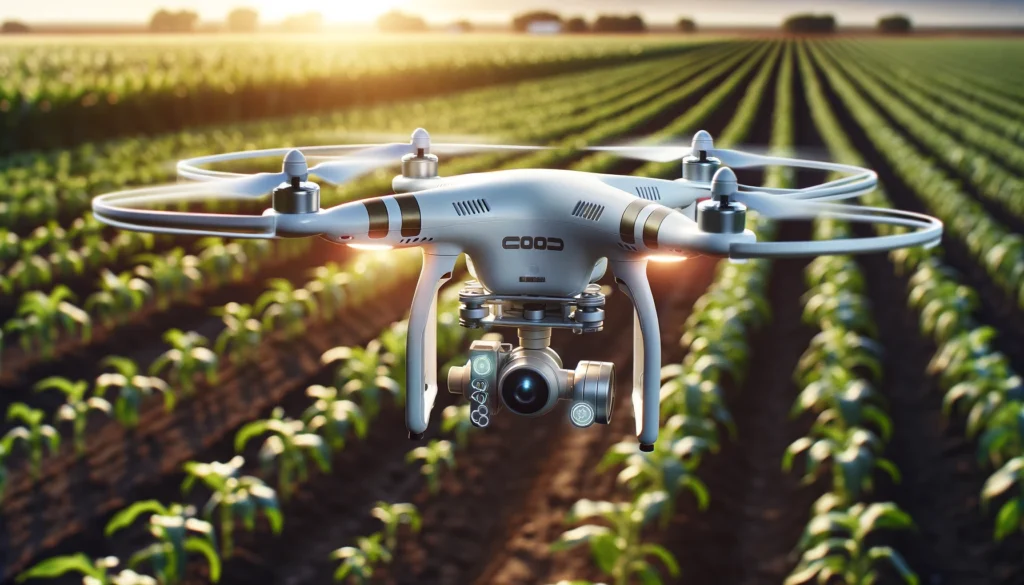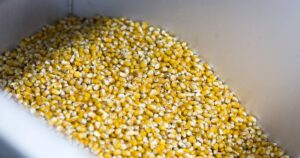
Agriculture Dictionary A close up shot showcasing drones in agriculture. The focus is on a drone equipped with sensors and cameras flying over a field of crops. The drones2.webp.webp
Definition: Drones in Agriculture
Drones in agriculture, also known as unmanned aerial vehicles (UAVs), are used for aerial surveillance and monitoring of crops, livestock, and agricultural infrastructure. These drones are equipped with cameras, sensors, and GPS technology to capture high-resolution images and data. They provide valuable insights into crop health, pest infestations, irrigation needs, and field conditions. The use of drones in agriculture enhances precision farming by allowing farmers to make informed decisions, optimize resource use, and improve overall productivity.
Drones in Agriculture: An In-Depth Guide
Introduction
Drones have become a transformative tool in modern agriculture, offering farmers a new perspective on their fields and operations. This guide explores the different types of agricultural drones, their benefits, and best practices for their implementation and use. Understanding these technologies can help farmers optimize their operations and achieve better outcomes.
Fall off the barn roof and busted your keister? Life on the farm or ranch can be tough on the bum. Need a break? Laugh it off at FarmerCowboy.com, the #1 farm humor site. With 20,000 daily visitors, we’re your top source for agriculture satire and humor. Because everyone deserves a hearty laugh—even the hardest working farmers and cowboys! Join us and turn those long days into fun tales at FarmerCowboy.com.
Types of Agricultural Drones
Agricultural drones can be categorized based on their applications and capabilities:
1. Imaging Drones
Imaging drones are equipped with high-resolution cameras and sensors that capture detailed aerial images of crops and fields. These images are used for:
2. Multispectral and Hyperspectral Drones
These drones use multispectral or hyperspectral sensors to capture data beyond the visible spectrum. They are used for:
- Nutrient Management: Assessing plant nutrient levels and identifying deficiencies.
- Soil Health Monitoring: Detecting variations in soil properties and moisture levels.
- Pest and Disease Detection: Identifying early signs of pest infestations and diseases.
3. Spraying Drones
Spraying drones are designed to apply pesticides, herbicides, and fertilizers to crops. They offer precise application, reducing waste and minimizing environmental impact. Benefits include:
- Targeted Spraying: Applying chemicals only where needed, reducing costs and environmental harm.
- Uniform Coverage: Ensuring even distribution of inputs across the field.
4. Livestock Monitoring Drones
These drones are used to monitor livestock health and behavior from the air. They can track the location of animals, assess their condition, and detect issues such as illness or injury.
Key Features of Agricultural Drones
Modern agricultural drones come equipped with various features to enhance their functionality and efficiency:
1. High-Resolution Cameras
Cameras on drones capture detailed images and videos, providing a clear view of crops and fields.
2. Advanced Sensors
Sensors such as multispectral, hyperspectral, and thermal imaging sensors collect data on crop health, soil conditions, and environmental factors.
3. GPS and Navigation Systems
GPS technology ensures precise navigation and positioning of drones, enabling accurate data collection and targeted applications.
4. Real-Time Data Transmission
Many drones transmit data in real-time, allowing farmers to make immediate decisions based on current field conditions.
Benefits of Drones in Agriculture
Implementing drones in agriculture offers numerous benefits:
- Increased Efficiency: Drones provide rapid and detailed assessments of fields, saving time and labor.
- Cost Savings: By optimizing input use and identifying issues early, drones help reduce costs associated with pesticides, fertilizers, and water.
- Enhanced Precision: Drones offer precise monitoring and application capabilities, improving crop yields and resource management.
- Improved Sustainability: Targeted application of inputs and early detection of issues promote sustainable farming practices.
- Better Decision-Making: Data collected by drones helps farmers make informed decisions about field management and resource allocation.
Challenges in Implementing Drones in Agriculture
Despite their benefits, implementing drones in agriculture can present several challenges:
- High Initial Costs: Investing in advanced drones and sensors requires significant capital, which can be a barrier for small and medium-sized farms.
- Technical Complexity: Operating and maintaining drones requires specialized knowledge and training.
- Data Management: Managing and interpreting the large amounts of data generated by drones can be challenging.
- Regulatory Issues: Compliance with aviation regulations and obtaining necessary permits can be complex and time-consuming.
- Dependence on Infrastructure: Reliable internet connectivity and power supply are essential for the effective use of many drone technologies.
Best Practices for Implementing Drones in Agriculture
To maximize the benefits of drones, consider the following best practices:
1. Conduct a Needs Assessment
Evaluate your farm’s specific needs and challenges to identify the most suitable drone technologies. Consider factors such as crop type, field size, and resource availability.
2. Invest in Training
Ensure that all operators and farm workers receive proper training on using drones. This includes understanding how to operate the technology, interpret data, and perform routine maintenance.
3. Start Small
Begin with pilot projects to test new drone systems on a small scale before full-scale implementation. This allows you to identify potential issues and make necessary adjustments.
4. Prioritize Data Management
Develop a robust data management strategy to ensure data collected from drones is accurate, secure, and accessible. This includes investing in reliable data storage and analytics platforms.
5. Collaborate with Experts
Work with technology providers, agricultural consultants, and research institutions to stay updated on the latest advancements and best practices in drone technology.
Case Study: Successful Implementation of Drones in Agriculture
The Lopez Family Farm
The Lopez family operates a 1,500-acre mixed crop farm. They successfully integrated various drone technologies into their operations, leading to significant improvements in productivity and sustainability. Key elements of their success included:
- Imaging Drones: The Lopez family used imaging drones to monitor crop health and assess field conditions, allowing for timely interventions and better management.
- Multispectral Drones: These drones provided detailed data on soil health and nutrient levels, optimizing fertilization practices.
- Spraying Drones: Spraying drones ensured precise application of pesticides, reducing costs and environmental impact.
- Livestock Monitoring Drones: Drones helped monitor the health and behavior of their livestock, improving animal welfare and productivity.
Results
The Lopez family’s investment in drone technology led to increased crop yields, improved resource efficiency, and enhanced sustainability. The use of drones contributed to cost savings and better overall farm management.
Conclusion
Drones are essential tools for the efficiency and productivity of modern agricultural operations. By investing in advanced drone technology, farmers can enhance their operations and support sustainable farming practices. Understanding the different types of agricultural drones and best practices for their implementation and use is crucial for maximizing the benefits and ensuring the long-term success of a farm.
How Knowledge of Drones in Agriculture Can Help Farmers
Understanding drones in agriculture helps farmers make informed decisions about technology investments, maintenance, and upgrades. Knowledge of different types of drones and their applications enables farmers to optimize resource use, enhance productivity, and ensure the safety and welfare of their crops and livestock. This understanding also supports sustainable farming practices and long-term agricultural success.
Resources for Further Reading
To further explore drones in agriculture and related topics, visit the following resources:

Originally posted 2009-05-24 09:53:22.
Originally posted 2024-06-03 06:23:50.
Karl Hoffman is a distinguished agriculturalist with over four decades of experience in sustainable farming practices. He holds a Ph.D. in Agronomy from Cornell University and has made significant contributions as a professor at Iowa State University. Hoffman’s groundbreaking research on integrated pest management and soil health has revolutionized modern agriculture. As a respected farm journalist, his column “Field Notes with Karl Hoffman” and his blog “The Modern Farmer” provide insightful, practical advice to a global audience. Hoffman’s work with the USDA and the United Nations FAO has enhanced food security worldwide. His awards include the USDA’s Distinguished Service Award and the World Food Prize, reflecting his profound impact on agriculture and sustainability.




